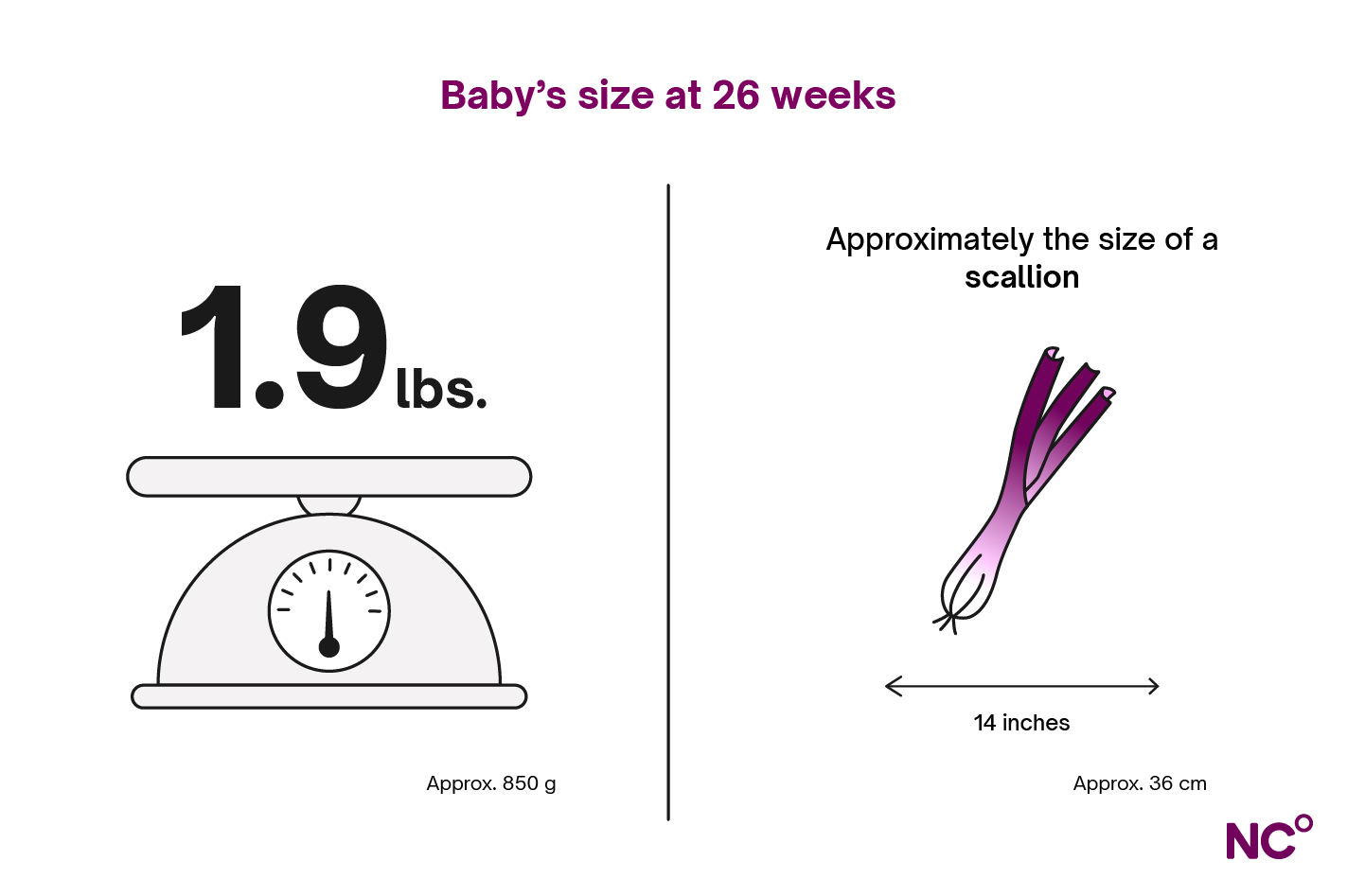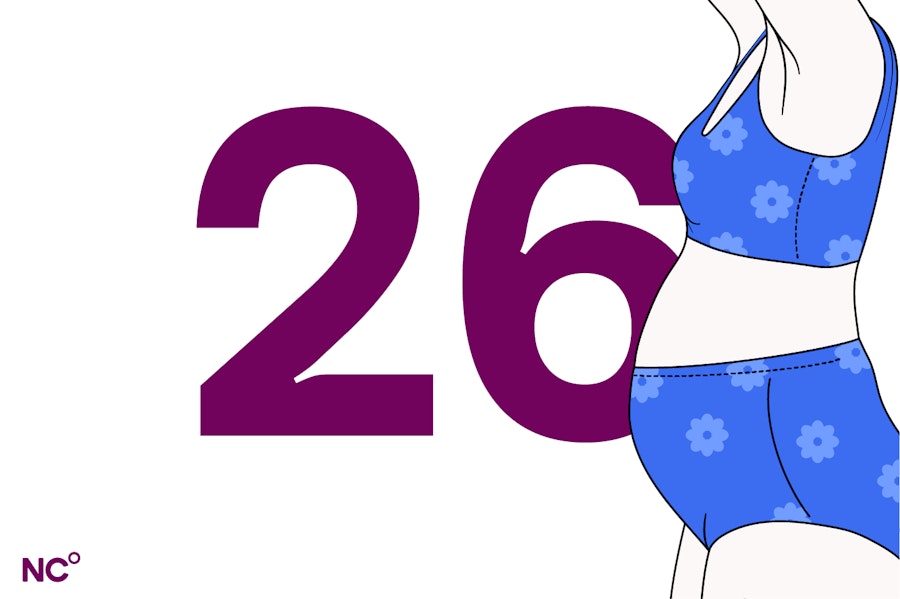26 Weeks pregnant: Symptoms, baby development & tips
Follows NC° Editorial Policy
At Natural Cycles, our mission is to empower you with the knowledge you need to take charge of your health. At Cycle Matters, we create fact-checked, expert-written content that tackles these topics in a compassionate and accessible way. Read more...
Key takeaways:
- While most headaches during pregnancy are normal, it’s important to be mindful that severe headaches and headaches that do not go away could be a sign a preeclampsia
- Your baby is starting to open their eyes this week as their eyes continue to mature and develop
- Gestational diabetes can develop in anyone, most often without symptoms, which is why a glucose tolerance screening test between weeks 24 and 28 is important for early detection
Welcome to week 26 and the final weeks of the second trimester. In this week’s article, we will talk all things headaches, coordination, balance, and leg cramps. We will also check in on your baby, who is working on their eye and lung development this week. Finally, we will discuss what gestational diabetes is and finish up with some tips for caring for your mind and body this week.
Your body at week 26
Headaches
Though most commonly a pregnancy symptom in the first and third trimesters, headaches can happen throughout your pregnancy and are linked to a number of factors, from hormone changes to lack of sleep, stress, dehydration, low blood sugar, and caffeine withdrawal [1]. You can try treating your headache at home with rest, a warm bath or shower, or a massage to relieve tension. Drinking enough water and making sure you eat small, regular meals throughout the day can also help.
Paracetamol and acetaminophen are considered safe to take during pregnancy as over-the-counter painkillers [2]. Be mindful that some acetaminophen tablets have caffeine, and it is generally advised not to exceed 200mg of caffeine (from all sources) per day.
In some cases, a bad headache can be a sign of preeclampsia. Preeclampsia is a high blood pressure disorder that requires medical monitoring for the safety of both the mother and the baby. While the causes of preeclampsia are not well understood, scientists believe it is linked to blood flow issues with the placenta [3]. The most common symptoms of preeclampsia are a severe headache, or a headache that does not go away, swelling of the face and hands, vision changes, pain in the upper abdomen or shoulder, and nausea or vomiting. If you experience any of these symptoms, contact your healthcare provider immediately.
Coordination and balance
Have you been having difficulty balancing while getting dressed or feeling particularly clumsy? Weight gain during pregnancy on account of the baby, placenta, amniotic fluid, and increased blood and fluid volume generally concentrates in the front and center of your body, which directly affects your center of gravity [4]. A shifting center of gravity combined with relaxation of your muscles and joints on account of pregnancy hormones can disturb your ability to balance and your motor coordination. Additionally, if you are suffering from pelvic girdle pain (which we discussed in the 25 weeks pregnant guide), it can worsen coordination and balance further [5].
While balance and mobility will recover during the postpartum period, you should exercise caution while engaging in tasks that could put you at increased risk of falling. This includes, for example, day-to-day activities that require balancing on one leg, exercise that requires coordination or balance, carrying other children, and riding public transportation standing. Physical activity continues to be important, so straight line or stationary activities like walking, jogging, swimming, and cycling (if safe to do so in your pregnancy) are ideal if you are dealing with balance and coordination issues.
Leg cramps
Cramps and muscle spasms in the legs are common in the second and third trimesters of pregnancy, resulting from changes in blood circulation and tiredness in your leg muscles [6]. In addition to being shocking and painful, they can disrupt your sleep and continue to ache for up to a day. To ease the pain of leg cramps, massaging the muscle vigorously can help increase blood flow to the affected area. If you experience a muscle spasm, try to gently pull your toes upwards with knees straight to stretch the calf muscle (pointing the toes down contracts the calf muscle).
You can try to prevent leg cramps by staying hydrated, stretching your leg muscles regularly, and making sure your diet includes the recommended amounts of calcium and magnesium. Light, regular exercise can also help with circulation. If your leg cramps are severe or persistent, contact your healthcare provider to see if they have recommendations regarding supplements or exercises to improve flexibility and circulation. You should also contact them if you experience swelling or redness, as this might be a sign of a more serious condition.
Your baby’s development at 26 weeks
About the size of a scallion, your baby is measuring around 13.4 to 14 inches (34-36 centimeters) and weighing 1.7 to 1.9 pounds (760 to 850 grams) [7].

At 26 weeks, your baby is just beginning to partially open its eyes [8]. Their first eye movements are mostly reflexive, as their eyes continue to open and develop all the way until birth. You might also periodically feel rhythmic pulsing or movements in your belly. These are not a heartbeat, but likely hiccups — the result of your baby swallowing amniotic fluid. While scientists are not sure why babies get the hiccups in utero, some studies have suggested that hiccups can play a role in lung development [7].
Managing gestational diabetes
Between weeks 24 and 28, you will likely have an oral glucose tolerance test to screen for a type of diabetes called gestational diabetes. Gestational diabetes is a condition that develops in pregnancy when your body cannot produce enough insulin to control your blood sugar levels [9]. Because it can cause problems for both you and your baby, early detection is key to managing the condition throughout pregnancy.
Anyone can develop gestational diabetes, but there is an increased risk if you are overweight, have given birth to a baby who weighed over 9 pounds (4 kilograms), have had gestational diabetes in a previous pregnancy, or have a family history of type 2 diabetes [10]. Gestational diabetes often does not have any symptoms, but can lead to issues in your pregnancy, like your baby growing larger than usual, having too much amniotic fluid, premature birth, and preeclampsia, which is why early detection is important [9].
If you are diagnosed with gestational diabetes, you will likely be given a blood sugar testing kit so that you can monitor your blood sugar. You will also be given recommendations and advice on changing your diet, and likely be encouraged to stay active in order to lower your blood sugar and make your body more receptive to insulin [10]. In some cases, medicine might be prescribed.
While gestational diabetes typically goes away after birth, it’s important to know that having gestational diabetes in one pregnancy increases the likelihood it will develop in subsequent pregnancies. About half of women who get gestational diabetes when pregnant will develop type 2 diabetes later in life, so it is important to talk to your doctor about managing your risk after you’ve given birth [10].
Tips in week 26
- Avoid drinking too much at night: While it’s important to stay hydrated during the day, your growing baby will likely place more and more pressure on your bladder in the weeks and months to come. Try to moderate how much you drink in the evenings to avoid having to get up in the night to use the bathroom.
- Remember your posture: The way you hold your posture can make a difference. Slouching, overarching, or sitting in the same position for too long may add pressure to your neck, back, and pelvis, which can worsen existing pelvic or hip discomfort and contribute to headaches. Try to stay aware of your posture when sitting and standing — small adjustments can help. Aim to gently tuck your pelvis to avoid arching your lower back, keep hips and knees at 90-degree angles, and align your ears over your shoulders and your shoulders over your hips.
- It’s ok to be anxious about childbirth: As you head into your third trimester, you will likely begin thinking about childbirth. It is completely normal and expected to have questions or concerns. While there is no shortage of reliable sources online, it’s easy to inadvertently land on a page that can trigger or worsen uncertainty. Speak with your nurse, midwife, or doctor, and remember, there are no dumb questions. Your healthcare team can recommend sources, classes, and additional counseling to help support you through this time.
- Familiarize yourself with the difference between Braxton Hicks and labor contractions: In the third trimester, or sometimes earlier, you might begin to feel cramps or pressure periodically in your lower abdomen and wonder if you are going into labor. Knowing the difference between Braxton Hicks contractions and labor contractions can help you stay calm in the moment. While labor contractions will continue, without stopping, at regular but decreasing intervals and get stronger over time, Braxton Hicks contractions will come and go irregularly and can even stop if you change positions or get a drink of water.
Using Natural Cycles during your pregnancy
Natural Cycles is best recognized as the first FDA Cleared birth control app. But did you know you can use Natural Cycles throughout your pregnancy as well as postpartum? NC° Follow Pregnancy was designed to support you by providing weekly guides, symptom trackers, and informative articles throughout the duration of your pregnancy. After giving birth, NC° Postpartum will help you during your recovery and can be used to prevent pregnancy when ovulation returns.
Did you enjoy reading this article?
